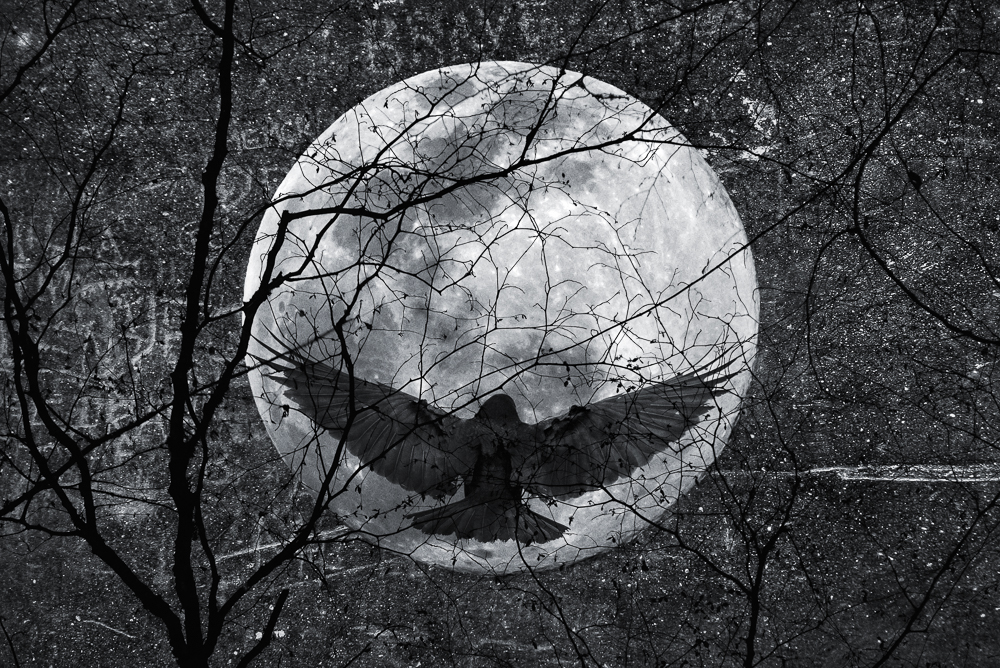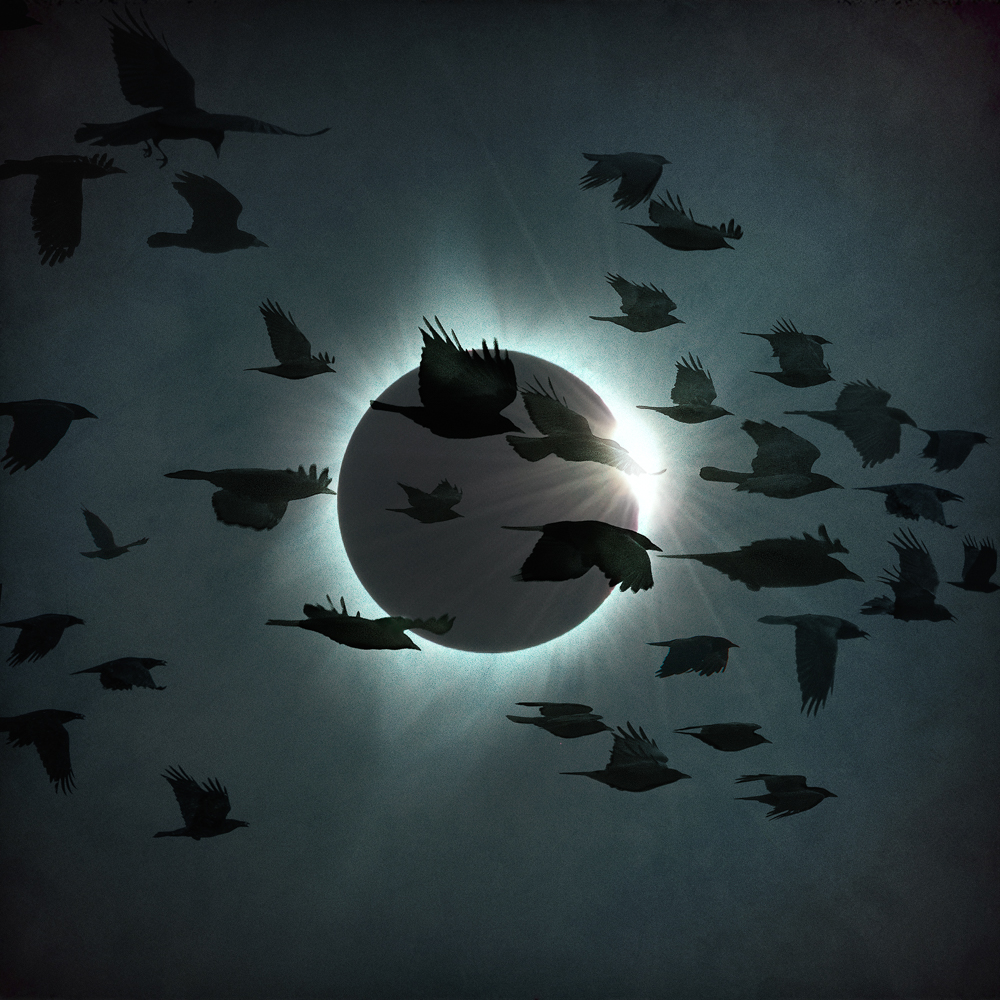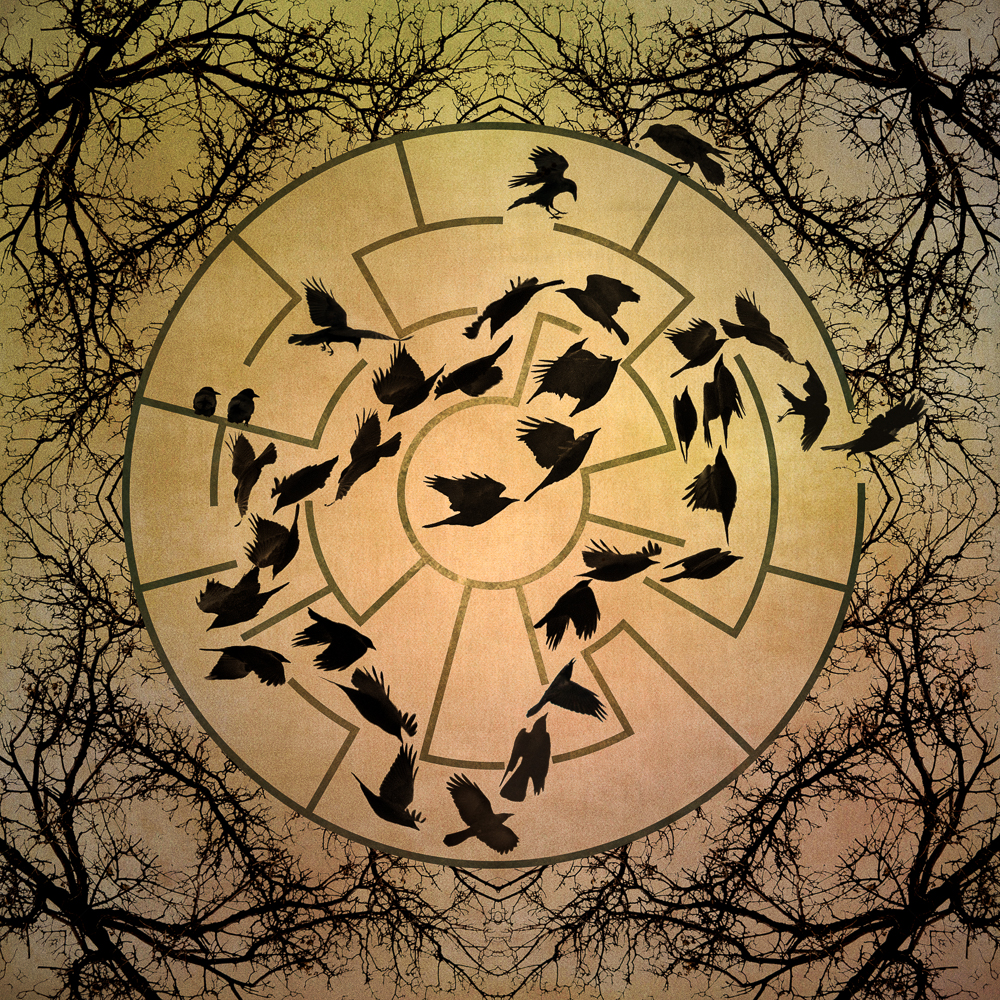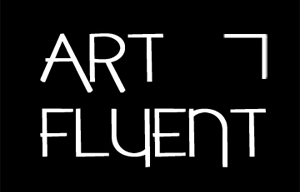
Magritte's Leftovers, composite digital photograph
-Larry, we'd love to hear your story and how you got to where you are today, both personally and as an artist.
I have been interested in photography as an art form since I was a teenager and sold photographs at art fairs as long ago as the early 1970s. It became a serious pursuit for me in the late 1990s when the rapid acceleration in the technical quality of digital photographs began, allowing me to use that medium to express myself. That marked the beginning of an intensive period of self-discovery and advancement of my art that still continues today.
I was well suited to the switch to digital photography because of my background in science and particularly computers. By combining creativity with mechanical and technical skills, photography meets the needs of both the left and right sides of my brain. I work with both representational photography and interpretive images. Composite images became a major focus of my work in 2012. Using multiple images in one composition, I am able to move past the traditional boundaries of the medium of photography, opening new paths for expressing my creative thoughts.
I have never relied on photography to support myself, instead I pursued other career interests. While certainly taking time away from my photography efforts, this lifestyle freed me from the constant worry of wondering whether or not the photographs I produced would sell. This was a huge benefit to my desire to just be able work unconstrained in whatever artistic direction I chose.
I grew up in Kansas, finished a degree in Sociology at Wichita State University and moved to Arizona for graduate school. Later, I took a job with the Indian Health Service in Anchorage Alaska, where I met my wife Connie. We married in Bozeman, Montana while building our first home and going to graduate school at Montana State University. I completed a PhD in Biostatistics at the University of Alabama at Birmingham in 1989. We then moved to Idaho Falls, Idaho where I worked at the Idaho National Laboratory as a statistician all the while following my photographic interests. In 2007, I retired from statistics work and we moved back to our Bozeman home and have been engaged in photography full-time ever since.

Brave, composite digital photograph
-Can you describe the process of creating composite photographs in your work? What inspired you to use this technique?
I started working with composite photographs when I found myself visualizing compositions in my head that I knew did not lend themselves to straight photography. In the beginning I created very structured, often geometric images such as variations on mandalas and the like. Gradually I shifted to less rigidly structured creations.
I believe the kernel ideas for my composite work come from waking dreams; dreams which occur during periods when one is neither fully awake nor fully asleep. During this time the mind can produce sometimes surprisingly vivid tableaus of rearranged fragments of unrelated memories. It is this sense of an altered reality that these composite photographs are meant to express.
Beyond the initial kernel idea for a composition, I don’t follow any structured route to completion. The work proceeds intuitively and without deep conscious thought, relying heavily on free association. I work spontaneously by browsing the extensive library of images I’ve taken over the years for items that somehow seem to fit organically in the composition. I believe my subconscious is often directing the selection process.
I run into a lot of dead ends using this method and often have to back up and start in another direction, looking for something that is visually pleasing and has some cohesive meaning to me. Symbology, including the use of icons (often in an iconoclastic way) figure highly in the images, but my interpretations of them come after the fact rather than guiding the direction of their creation.
While I have photographed all over the US and around the world, I’ve lived in Bozeman most of my adult life, so my work is heavily centered on southwest Montana and the Greater Yellowstone Ecosystem. Often starting with images from Yellowstone and its environs, I incorporate bits and pieces of photographic memories from my experiences elsewhere, recontextualizing them to form surreal combinations.

Becoming Raven, composite digital photograph
-Your work stands out as striking and surreal. Could you share your method for creating a distinct visual style that makes your work unique?
My personal style derives from my emphasis on aesthetic appeal and an adherence to my own loosely defined rules of composition. These compositional “rules” aren’t really rules at all, just general patterns and consistencies in the way I select subjects and compose their arrangement in the images. I believe that everything an artist experiences in their life has an affect, sometimes major, sometimes subtle, on the work they produce. In my case, my methods are the result of a variety of influences, of note my attraction to structured and ordered compositions, my background in mathematics and statistics, and experience in graphical representation of data. At the same time, these more rigid influences are tempered by my willingness to let my subconscious take over in the creation process.
My work relies heavily upon the subconscious to recontextualize archetypes and symbols that are placed alongside other objects to suggest a surrealistic personal meaning to the imaginative viewer. Building upon this recontextualization, I construct guided narratives in the portfolio, sometimes directed by inferable titles, enticing the viewer to create their own story. For example, the title The Secret of the Rooky Wood and its associated composition recontextualize a quote from Shakespeare’s Macbeth.
Finally, I employ mythical archetypes in this visual equation to assist the viewer’s ability to create their own narrative while employing their own subconscious associations. Corvids, in particular crows and ravens, are frequent subjects in my compositions. Their iconic ubiquity in myth, folklore, and literature make them natural vehicles for Surrealist projections and narratives. They are often placed near another universal iconic symbol, the circle, as it occurs in mandalas, mazes, and other graphic and organic configurations that can add additional significant meaning to a composition.
I’ve been highly influenced by my visits to some of the world’s best art museums, and it is this exposure more than anything else that has lead to my interest in creating surrealistic composite photographs. I can visit a museum and immediately upon leaving be able to view my surroundings in a heightened state of awareness that is not generally present, and this carries over into my photography and the creation of composite images. The styles of Magritte, Escher, de Chirico and Dali in particular have been very inspirational to me when creating my own work, but many other artists have influenced my work as well. I photograph extensively (when allowed) in museums and certain artwork, especially sculptural pieces, often appear in my compositions.
While most of the effects of museum experiences on my work are more general in nature, I do have a set of images I call The Masters in Yellowstone in which I’ve tried to imagine how famous artists (e.g. Magritte, Rembrandt, J.M.W. Turner, Klimt and Escher) might have responded to a visit to Yellowstone National Park.
Many of my images address, at least tangentially, environmental problems related to overcrowding, climate change and other issues. The exposition of these issues is often presented with a touch of humor meant to ease stress related to considering the seriousness of the issues.

Victory of the Seven Sisters, composite digital photograph
-In many of your artworks, light appears to play a significant role. Can you delve into how you use light to tell a story and convey a certain narrative?
I generally steer away from subtle imagery, although I appreciate them in general and specifically when I happen to create one myself. But my own personal style just does not seem to lean in that direction. Hence, I love strong shadows, which of course you cannot have without an actual or implied strong directional light. In a composite image you are able to create shadows as necessary to emphasize important components of the story line, thus aiding the narrative. This is something I picked up from studying de Chirico’s paintings among those of other artists. Specifically light and shadow can be used to direct the viewer’s eye through a composition, creating a story line as it goes. The high contrasts that occurs with definitive light and shadows makes the image pop, creating additional impact.

Day as Night, composite digital photograph
-What’s the best way for someone to check out your work and provide support?
I have a website, www.larryblackwood.com that shows many portfolios of my work, composite images as well as others. I maintain a blog where I post a photograph every day, hence the name “Picture of the Day” or simply POTD. The blog is integral to my website at www.larryblackwood.com/blog I also maintain two Instagram accounts @larryblackwood for my black and white work and @larryblackwood_color for my color work, including composite images.
I actively sell my images, bare prints as well as framed, at several galleries in Montana and also online. I don’t currently have an online store, but people can contact me personally at larry@larryblackwood.com with inquiries.
Statement
Synthesizing Icons is comprised of composite photographs: images created by combining components from different photographs in order to create a new composition. The compositing process creates new narrative tableaus, leaning heavily towards Surrealism in which objects or animals are dissociated from their usual context and placed in unrelated relationships to create new or exaggerated meaning.
The creation of composite photographs dates back to the political photomontage work of Dadaist photographers such as Hannah Höch, George Grosz, and Raoul Hausmann in the early twentieth century. After World War I, many Dadaists moved on to the similarly-structured Surrealist movement. The Surrealists were heavily influenced by Sigmund Freud’s text The Interpretation of Dreams. In his influential analysis, Freud presents dreams as an access point to the subconscious and deeper nuances of desire and emotion that are often suppressed by societal taboos in the waking life. Photomontage was a perfect approach for experimenting with automatism;

Apocalypse Dogs, composite digital photograph
employing free association by juxtaposing unlike images to analyze the subconscious mind. According to Giorgio de Chirico, “Although the dream is a very strange phenomenon and an inexplicable mystery, far more inexplicable is the mystery and aspect our minds confer on certain objects and aspects of life.”
My interpretation of Surrealism is inspired by waking dreams which occur during the period when one is neither fully awake nor fully asleep. During this liminal state, the mind can produce surprisingly vivid tableaus of rearranged fragments of unrelated memories. It is from this pseudo-conscious state that these composite photographs are derived.
My work relies upon the subconscious to recontextualization archetypes and symbols when placed alongside other objects to create personal meaning to the imaginative viewer. Building upon this recontextualization, I construct narratives in the portfolio. Through the comparison of images, sometimes directed by inferable titles, the viewer is invited to create their own story. For example, the title The Secret of the Rooky Wood and its associated composition recontextualize a quote from Shakespeare’s Macbeth.
Finally, I employ mythical archetypes in this visual equation to assist the viewer’s ability to create their own narrative while employing their own subconscious associations. Corvids, in particular crows and ravens, are frequent subjects in my compositions. Their iconic ubiquity in myth, folklore, and literature make them natural vehicles for Surrealist projections and narratives. They are often placed near another universal iconic symbol, the circle, as it occurs in mandalas, mazes, and other graphic and organic configurations that can add additional significant meaning to a composition.
Many of my images address, at least tangentially, environmental problems related to overcrowding, climate change and other issues. The exposition of these issues is often presented with a touch of humor meant to ease stress related to considering the seriousness of the issues.
Bio

The Secret of the Rooky Wood, composite digital photograph
Larry is a fine art photographer from Bozeman, Montana. Originally from Kansas, he considers himself a Montana semi-native since he has lived here over half his life!
Primarily self-taught, He has spent over 40 years exploring self-expression through photography. He originally worked in a black and white darkroom environment. With the advent of advanced techniques, he switched to digital methods around 1998. That marked the beginning of an intensive period of discovery and advancement of his art that still continues today.
By combining creativity with mechanical and technical skills, photography meets the needs of both the left and right sides of Larry’s brain. He works with both representational photography and interpretive images. Recently, composite images have been the focus of his work. Using multiple images, He is able to move past the traditional boundaries of the medium of photography, opening new paths for expressing his creative thoughts. The animal world (particularly crows, ravens, and magpies), symbology, and references to literary, cultural, and mythological icons form the basis of his creations.
Larry has had major solo exhibitions of his photographs in venues including the Wichita Art Museum, the Center for Contemporary Arts, the Museum of Idaho, the Hockaday Museum of Art, the Art Museum of Southeast Idaho, the Viewpoint Photographic Art Center, the Holter Museum of Art and the Emerson Center for Art and Culture as well as several galleries and museums in China. His work has also been featured in major fine art photography publications including LensWork, B&W, and Color. International competitions awards include the World Photography Awards and the B&W Spider Awards.
